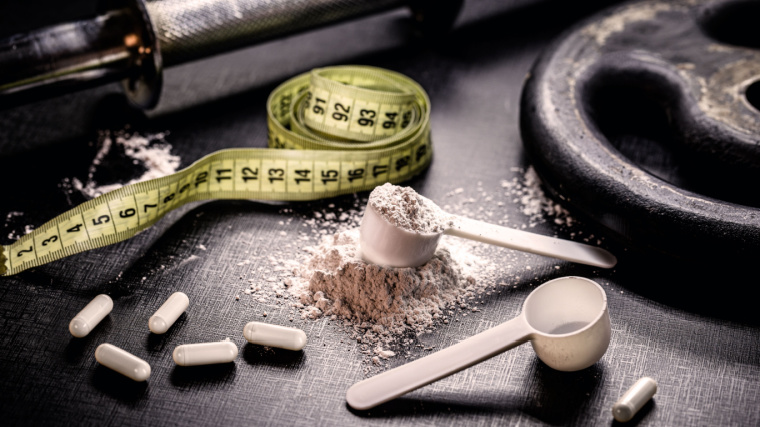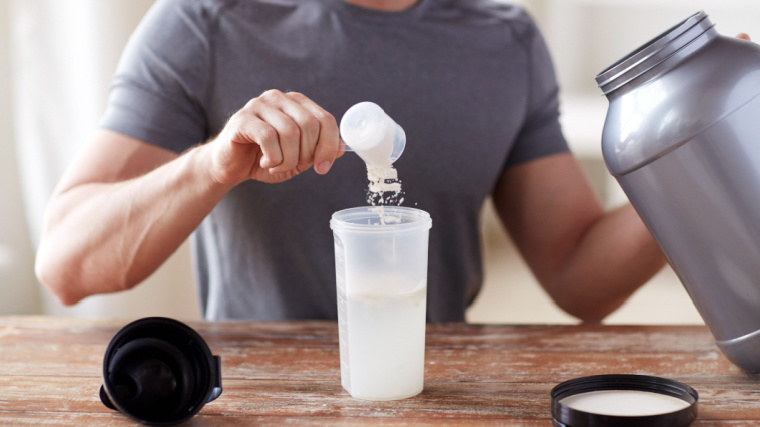Creatine is one of the most researched and widely used supplements in the strength sports world, credited with boosting strength, power output, and muscle growth. However, there’s ongoing debate about the optimal timing for creatine supplementation: should you take creatine before or after a workout?
You might want to consume creatine with pre-workout to prime your muscles for maximum workload during all those heavy barbell exercises. Or you might want to toss some creatine powder into your post-workout shake to replenish those creatine stores. Here, you’ll learn about the optimal way to use this dietary supplement to aid muscle recovery and build muscle.

Whether you’re a weightlifting veteran or someone just starting on their fitness journey, understanding when to take creatine can help you maximize its benefits and achieve your performance goals.
What Is Creatine?
Creatine is a naturally occurring compound made of the amino acids arginine, glycine, and methionine. Your body produces it naturally, and though it’s primarily found in skeletal muscles, small amounts are also stored in the brain, heart, liver, and kidneys in the form of creatine phosphate.
You can also consume foods with creatine, like red meat or fish, and by using creatine supplements. (1)(2)
Creatine works by playing a role in energy metabolism for multiple organs. In the context of exercise and athletic performance, it serves as a rapid but limited source of energy for high-intensity, short-duration activities like sprinting or hitting a one-rep max.

[Read More: The Complete Guide to Pre-Workout Supplements]
It does so by donating its phosphate group to adenosine diphosphate (ADP), converting it back to adenosine triphosphate (ATP), the “energy currency” of the cell. (1)(2)
Creatine supplementation saturates muscle cells with creatine, which increases the cell’s capacity to regenerate ATP and therefore perform better when energy demands are high for short bursts of time. (1)(2)
Should You Take Creatine Before or After a Workout?
Unlike many pre-workout supplements that work within a specific period of time after ingestion, creatine can boost your performance no matter when you take it. There are still a few considerations, though.
Since caffeine might diminish the ergogenic effects of creatine, it may be better to take your creatine post-workout if you like to caffeinate before you hit the gym. There’s also some evidence that creatine can enhance glycogen restoration when taken with carbohydrates after a workout. (3)(4)
[Read More: The 12 Best Women’s Multivitamins]
On the other hand, taking your creatine two hours before your workout — without caffeine — could facilitate better absorption. (3)(4)
That being said, these minor differences in absorption have little impact on the benefits of supplementation, so it’s best to simply take it at the time you’re most likely to remember it. That will always be superior to forgetting to take it at all. (3)(4)
How Much Creatine Should You Take?
While you don’t need to be too concerned about creatine timing, you definitely want to take the right dose of creatine intake. The general recommendation is simply to take three to five grams of creatine per day, but you can get more specific to maximize your results. (1)(3)(5)
A creatine loading phase is an efficient but optional way to fill your creatine phosphate stores. It involves supplementing with large doses for the first few days before switching to a smaller maintenance dose. (3)(5)
[Read More: The 7 Strongest Pre-Workouts]
A six-day loading phase with daily doses of 20 grams (broken into two 10-gram servings) can raise muscle creatine concentrations by 20 percent. Achieving the same result with a daily intake of three to five grams could take up to 28 days. (3)(5)
Alternatively, creatine dosage can be tailored to body weight: the loading phase would involve around 0.3 grams per kilogram of body weight per day, followed by a reduced maintenance dose of approximately 0.1 grams per kilogram. (3)
How to Take Creatine
Creatine can be mixed into a variety of foods and beverages. One interesting study compared the absorption of creatine in a liquid, gel, hard candy, or red meat, and found that it was absorbed more rapidly in liquid form. However, they all led to significant elevations in circulating creatine levels. (6)
If you’re trying to saturate your creatine stores as quickly as possible, it’s probably best to mix your creatine into a beverage. But if you prefer mixing it into your morning oats or the milk for your cereal, you’ll still benefit just as much.

[Read More: The 10 Best Multivitamins for Men]
Because creatine is hydrophilic — meaning that it attracts water — large doses can retain too much water in the intestine. So, if you decide to opt for a loading protocol, it’s important to break that large 20 to 25-gram dose into two or three smaller doses of seven to 10 grams in order to prevent gastrointestinal distress. (3)(5)
The only wrong way to take creatine is to “dry scoop” it, or to ingest the powder dry, without anything to facilitate swallowing or prevent choking. This recent social media trend is based on clout, not science, and is generally quite dangerous. (7)
What Form of Creatine Is Best?
Creatine monohydrate is considered to be the most bioavailable form of creatine, and it’s often the most cost-effective and shelf-stable method. In fact, other types of creatine often have less of an impact than creatine monohydrate. (3)
Take Your Creatine
For bodybuilders and other strength athletes aiming to increase strength and lean muscle, creatine can be a powerful ally. Post-workout creatine and pre-workout creatine can both be helpful in this process. You can take creatine before or after your workout for maximum gains. So load up whenever you’d like, and enjoy your muscle growth.
FAQs
Athletes who want to give a boost to their high-intensity training may be pumped about the possibilities of creatine. Here are the answers to some of your most pressing questions.
Creatine is effective whether you take it before or after your workout. It will be absorbed fastest if it’s mixed into a liquid. To avoid unpleasant gastrointestinal side effects, aim to avoid taking more than 10 grams at a time, even when creatine loading.
It’s best to take creatine at the time you’re most likely to remember to take it. You may want to avoid mixing creatine with caffeine if possible. You probably won’t see a noticeable difference in performance if you take it before versus after your workout.
Muscle creatine stores are broken down at a rate of about two grams per day, although this is generally replenished each day from the diet even without supplementation. (8)
These stores will never be completely depleted, but they will return to baseline after a while if you stop supplementing. While it may not make a difference to your lean body mass if you miss a dose from time to time, it’s best to take it daily.
Creatine is one of the most popular supplements available, and for good reason. It supports exercise performance, body composition, bone health, and brain health across a wide range of ages. Plus, it’s backed by plenty of solid research. Beginners can start taking creatine right away; there’s no need to wait for all the potential benefits of creatine.
References
- Forbes, S. C., Candow, D. G., Ostojic, S. M., Roberts, M. D., & Chilibeck, P. D. (2021). Meta-analysis examining the importance of creatine ingestion strategies on lean tissue mass and strength in older adults. Nutrients, 13(6), 1–14.
- Mills, S., Candow, D. G., Forbes, S. C., Neary, J. P., Ormsbee, M. J., & Antonio, J. (2020). Effects of creatine supplementation during resistance training sessions in physically active young adults. Nutrients, 12(6), 1–11.
- Antonio, J., Candow, D. G., Forbes, S. C., Gualano, B., Jagim, A. R., Kreider, R. B., Rawson, E. S., Smith-Ryan, A. E., VanDusseldorp, T. A., Willoughby, D. S., & Ziegenfuss, T. N. (2021). Common questions and misconceptions about creatine supplementation: what does the scientific evidence really show? Journal of the International Society of Sports Nutrition, 18(1), 1–17.
- Candow, D. G., Forbes, S. C., Roberts, M. D., Roy, B. D., Antonio, J., Smith-Ryan, A. E., Rawson, E. S., a, B., & Roschel, H. (2022). Creatine O’Clock: Does Timing of Ingestion Really Influence Muscle Mass and Performance? Frontiers in Sports and Active Living, 4(May), 1–8.
- Feurebacher, J., & Schumann, M. (2021). Short-Term Creatine Loading Improves Total Work and. Nutrients, 13.
- Harris, R. C., Nevill, M., Harris, D. B., Fallowfield, J. L., Bogdanis, G. C., & Wise, J. A. (2002). Absorption of creatine supplied as a drink, in meat or in solid form. Journal of sports sciences, 20(2), 147–151.
- Lin, A., Chow, N., O’Connor, M., Mehta, S., Behnam, R., Pham, D., Hatef, C., Rosenthal, H. E., & Milanaik, R. a2022). Dry scooping and other dangerous pre-workout consumption methods: A quantitative analysis. Pediatrics, 149(1 Meeting Abstracts February 2022), 204.
- Kraemer, W. J., & Volek, J. S. (1999). Creatine supplementation. Its role in human performance. Clinics in sports medicine, 18(3), 651–ix.
Featured Image: RHJPhtotos / Shutterstock
The post Should You Take Creatine Before or After a Workout? appeared first on BarBend.
